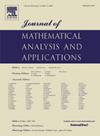Global solvability and unboundedness in a fully parabolic quasilinear chemotaxis model with indirect signal production
IF 1.2
3区 数学
Q1 MATHEMATICS
Journal of Mathematical Analysis and Applications
Pub Date : 2025-07-04
DOI:10.1016/j.jmaa.2025.129857
引用次数: 0
Abstract
This paper is concerned with a quasilinear chemotaxis model with indirect signal production, given by , and , posed in a bounded smooth domain , subjected to homogeneous Neumann boundary conditions. Here, the nonlinear diffusion D and sensitivity S generalize the prototypes and . Ding and Wang (2019) [8] showed that the system possesses a globally bounded classical solution if . In contrast, for the Jäger-Luckhaus variant of this model, in which the second equation is replaced by , Tao and Winkler (2025) [36] established that if and for , with radial assumptions, the variant admits finite-time blow-up solutions. We focus on the case and prove that the assumption for is sufficient for global solvability of classical solutions. Furthermore, if for , then radially symmetric initial data with large negative energy lead to blow-up happening in finite or infinite time. Both of these results imply that the system allows infinite-time blow-up if and for .
具有间接信号产生的完全抛物型拟线性趋化性模型的全局可解性和无界性
本文研究具有间接信号产生的拟线性趋化模型,由ut=∇⋅(D(u)∇u−S(u)∇v), vt=Δv−v+w, wt=Δw−w+u给出,置于有界光滑域Ω∧Rn中,服从齐次诺伊曼边界条件。其中,非线性扩散D和灵敏度S推广了原型D(S)=(S +1)−α和S(S)=(S +1)β−1s。Ding and Wang(2019)[8]表明,如果α+β<;min (1+2/n,4/n),系统具有全局有界经典解。与此相反,对于该模型的Jäger-Luckhaus变式,将第二式替换为0=Δv−∫Ωw/|Ω|+w, Tao和Winkler(2025)[36]建立了当n≥3时α+β>;4/n和β>;2/n,在径向假设下,该变式允许有限时间爆破解。重点研究了β<;2/n的情况,证明了当n≥2时β<;2/n的假设对于经典解的全局可解性是充分的。此外,当n≥4时α+β>;4/n,则具有大负能量的径向对称初始数据导致在有限或无限时间内发生爆炸。这两个结果表明,当α+β>;4/n和β<;2/n≥4时,系统允许无限时间爆破。
本文章由计算机程序翻译,如有差异,请以英文原文为准。
求助全文
约1分钟内获得全文
求助全文
来源期刊
CiteScore
2.50
自引率
7.70%
发文量
790
审稿时长
6 months
期刊介绍:
The Journal of Mathematical Analysis and Applications presents papers that treat mathematical analysis and its numerous applications. The journal emphasizes articles devoted to the mathematical treatment of questions arising in physics, chemistry, biology, and engineering, particularly those that stress analytical aspects and novel problems and their solutions.
Papers are sought which employ one or more of the following areas of classical analysis:
• Analytic number theory
• Functional analysis and operator theory
• Real and harmonic analysis
• Complex analysis
• Numerical analysis
• Applied mathematics
• Partial differential equations
• Dynamical systems
• Control and Optimization
• Probability
• Mathematical biology
• Combinatorics
• Mathematical physics.

 求助内容:
求助内容: 应助结果提醒方式:
应助结果提醒方式:


